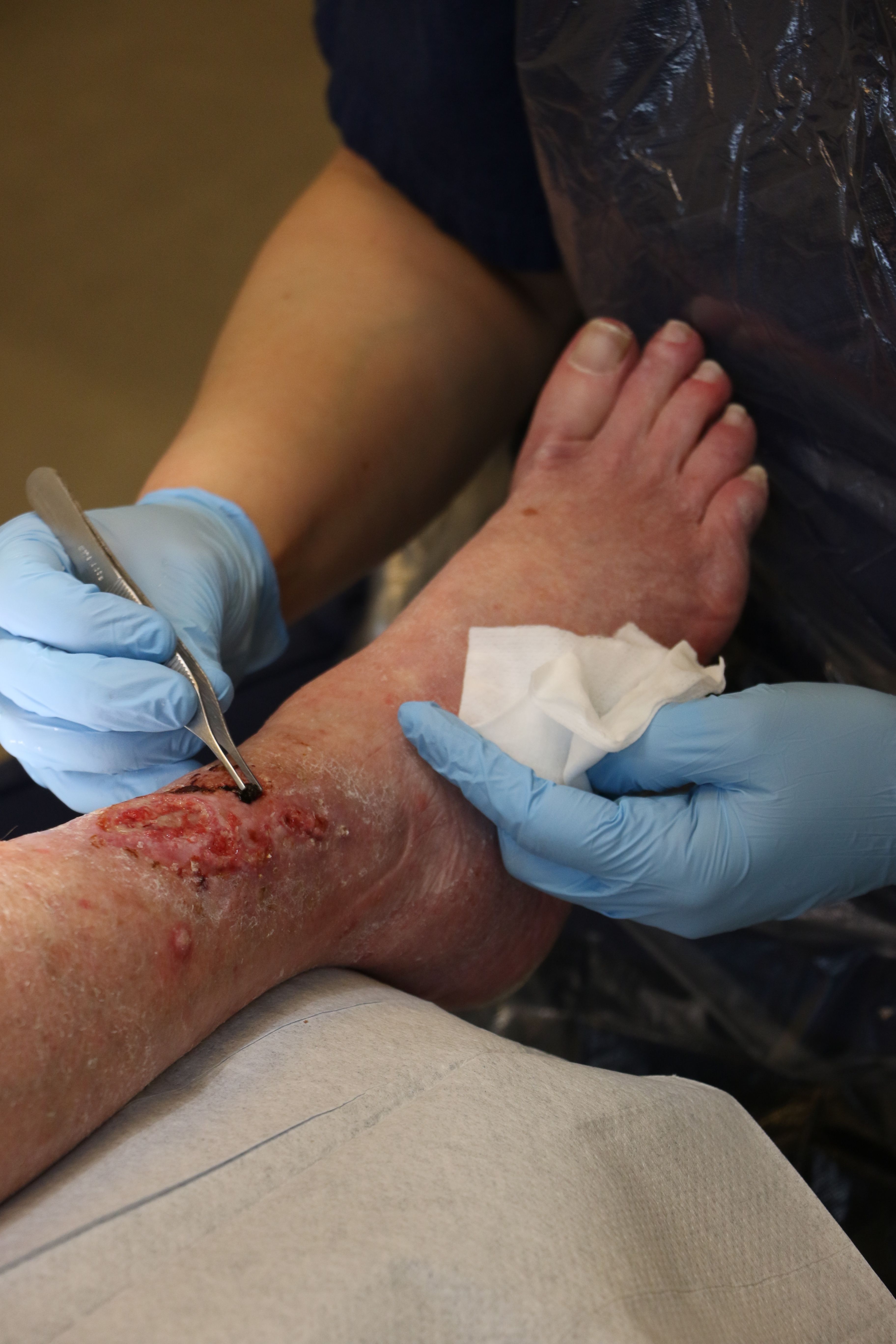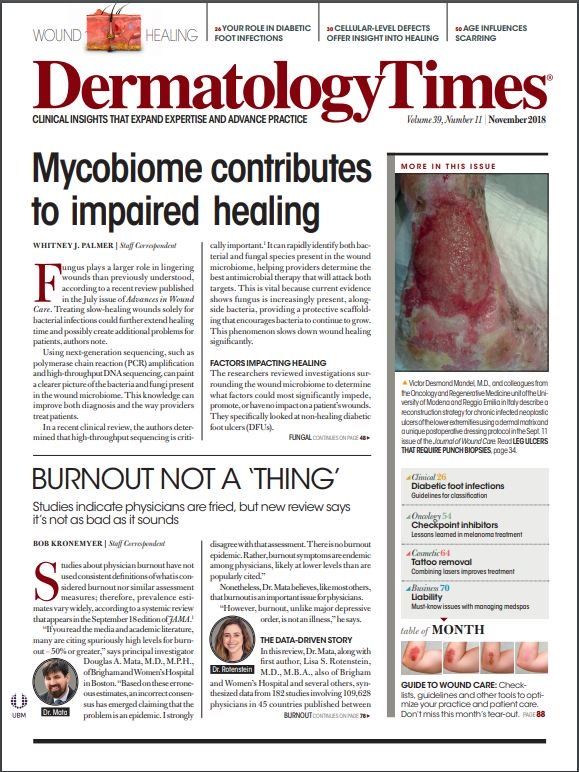- Case-Based Roundtable
- General Dermatology
- Eczema
- Chronic Hand Eczema
- Alopecia
- Aesthetics
- Vitiligo
- COVID-19
- Actinic Keratosis
- Precision Medicine and Biologics
- Rare Disease
- Wound Care
- Rosacea
- Psoriasis
- Psoriatic Arthritis
- Atopic Dermatitis
- Melasma
- NP and PA
- Skin Cancer
- Hidradenitis Suppurativa
- Drug Watch
- Pigmentary Disorders
- Acne
- Pediatric Dermatology
- Practice Management
- Prurigo Nodularis
- Buy-and-Bill
Publication
Article
Dermatology Times
Role of protease targets in wound healing uncertain
Author(s):
Protease modulating therapies are used to assist in venous leg ulcer closure, but a recent review suggests that physicians should reexamine the biomarker's role in targeted chronic wound healing therapies.
Protease modulating therapies are used to assist in venour leg ulcer closure, but a recent review suggests that physicans should rexamine the biomarker's role in targeted chronic wound healing therapies. (dragancfm - stock.adobe.com)

Protease modulating therapies are used to assist in venous leg ulcer closure. However, a recent systematic review of the evidence1 suggests a need to question the biomarker’s importance and further role in the future of targeted chronic wound healing therapies.
Earlier research reported in the literature has suggested that reducing protease levels can improve venous leg ulcer healing beyond the use of first-line treatments, such as compression, according to Maggie Westby, Ph.D., research fellow in the School of Health Sciences at the University
of Manchester, UK.
“Whilst protease-modulating (PM) dressings are available to achieve this, in this review we looked upstream to explore what the actual prognosis evidence was for an association between proteases and wound healing,” Dr. Westby said.
Dr. Westby and colleagues conducted a Cochrane systematic review to determine whether protease activity is an independent prognostic factor for the healing of venous leg ulcers. The review included prospective and retrospective longitudinal studies with any follow-up period that recruited people with venous leg ulcers. The authors investigated whether protease activity in wound fluid was associated with future healing of venous leg ulcers.
Eleven studies covering 10 different matrix metalloproteases (MMPs) and two serine proteases (human neutrophil elastase and urokinase-type plasminogen activators) and consisting of 13 cohorts with 522 participants had data available for the final analysis. Two studies assessed complete healing as the outcome; the remaining studies noted partial healing. A metaanalysis was not performed due to the varied methodologies, protease measurements and treatments. The collective evidence indicated complete uncertainty regarding the association between protease activity and venous leg ulcer healing.
If protease activity is shown to be independently associated with delayed healing, and existing or future treatments are shown to be effective in wounds with high protease levels, this could form part of a personalized medicine approach to wound care and, thus, proteases could be very valuable.
There is still potential for personalized medicine, but according to Dr. Westby, the current evidence base is insufficient to support this approach at the moment.
“We know that compression works, but there is a lot of uncertainty around the effectiveness of dressings in general and PM dressings in particular. As such, the evidence cannot inform whether clinicians should use or should not use protease modulating therapies,” she said.
Currently there is not enough known about the underlying mechanisms affecting delayed healing, and proteases may be only one of many biomarkers involved that can be modified using targeted treatments. The subsequent treatment strategy may differ from person to person.
There is a growing interest in the exploration of biomarkers that, if present in abnormal amounts, may be candidates for targeted treatment to improve outcomes. Biomarker prognosis reviews are new in the wound healing field and, according to Dr. Westby, they may allow the probing of mechanisms and pathways to help further our understanding of delayed healing, upon which targeted treatments could be researched and developed to improve outcomes.
“The protease prognostic factor systematic review highlights extreme uncertainty about the role of protease activity in wound healing. There is very limited research that elevated protease activity is associated with delayed healing. Whilst uncertainty can be frustrating in decision making, it is also important that we acknowledge it and are aware of it,” she added.
Protease modulating therapies may be a good future option; however, clinicians should make treatment decisions on the basis of the current evidence, Dr. Westby says, and consider recent multiple-intervention review findings2, patient views, costs and other outcomes data.
“Further research is in progress, and we hope that prognosis research in particular will lead to exciting future approaches in wound care,” Dr. Westby said.
DISCLOSURES:
Dr. Westby’s employment at the University of Manchester while completing this work was funded by a National Institute for Health Research (NIHR)-funded Cochrane program grant that focused on high-priority Cochrane Reviews in the prevention and treatment of wounds. This research was co-funded by the NIHR Manchester Biomedical Research Centre.
REFERENCES:1 Westby MJ, et al. Protease activity as a prognostic factor for wound healing in venous leg ulcers. Cochrane Database Syst Rev. 2018 Sep 1;9:CD012841. doi: 10.1002/14651858.CD012841.pub2.
2 Norman G, et al. Dressings and topical agents for treating venous leg ulcers. Cochrane Database Syst Rev. 2018 Jun 15;6:CD012583. doi: 10.1002/14651858.CD012583.pub2.







